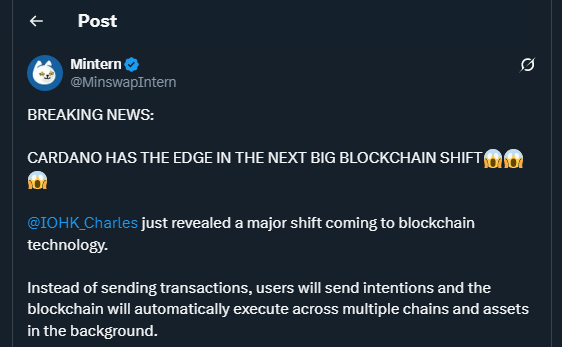TL;DR
- Cardano founder Charles Hoskinson emphasized that intent-driven transactions are emerging as a major advancement for blockchain usability, and highlighted that Cardano’s Extended-UTxO design equips the network to support these models with precision and predictable execution.
- The approach enables smoother automation across decentralized applications and multi-chain environments without compromising security.
- New developer standards and Vasil-era upgrades strengthen Cardano’s position as a scalable, user-centric and future-ready financial ecosystem.
Cardano is gaining renewed attention as Charles Hoskinson offers a forward-looking view on how blockchain networks will evolve toward a more automated and user-friendly environment. Speaking with Crypto Crow, he explained that intent-based systems allow users to express what they wish to achieve, while infrastructure takes care of executing it across protocols. He illustrated this by referencing how everyday purchases already rely on automated processes behind the scenes, even though the user only expresses a simple intention to pay.
Mintern, a contributor linked to the Cardano DEX Minswap, recently shared insights noting that Cardano’s architecture aligns naturally with this model. The network’s design favors efficiency, clarity, reliability and verifiable outcomes, which are essential characteristics for intent-driven decentralized finance.
Cardano’s Extended-UTxO Strength For Automation
Cardano’s Extended-UTxO ledger works with Plutus validators to ensure clear and predictable transaction outcomes before submission. This allows a wallet or dApp to construct a transaction knowing in advance how it will behave once confirmed on-chain. The Vasil upgrades introduced reference inputs, inline datums and reference scripts, all helping reduce friction and fees for automated execution. CIP-30 enables secure wallet-dApp interaction, while developers rely on the Plutus Application Backend and common SDKs to coordinate off-chain processes.
Real examples already exist on Cardano. DEX platforms use batchers that collect swap or liquidity requests with defined conditions and settle them efficiently in a single transaction. This mirrors how solver systems may evolve for wider use cases, from lending to real-world asset transfers. Meanwhile, Hydra continues to develop fast settlement options that preserve the same logic off-chain before returning to the base layer, supporting high-performance use cases.

Growing Adoption And Multi-Chain Potential
Other ecosystems are exploring intent-based methods through solutions such as UniswapX, CoW Protocol and smart account standards. Cardano takes a different route by offering deterministic execution and the ability to encode the intent itself as UTxO data. NEAR’s addition of ADA support in its intents platform shows how Cardano could integrate more easily into multi-chain routing and cross-chain automation in the future.











